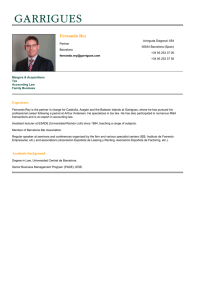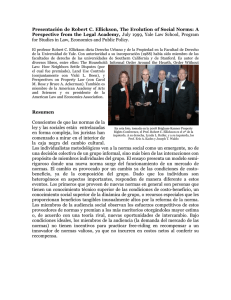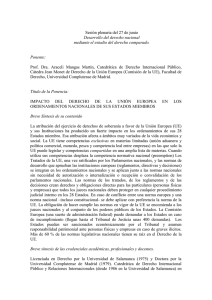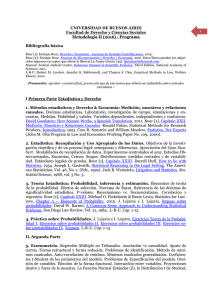Segundo Semestre 2015
Anuncio
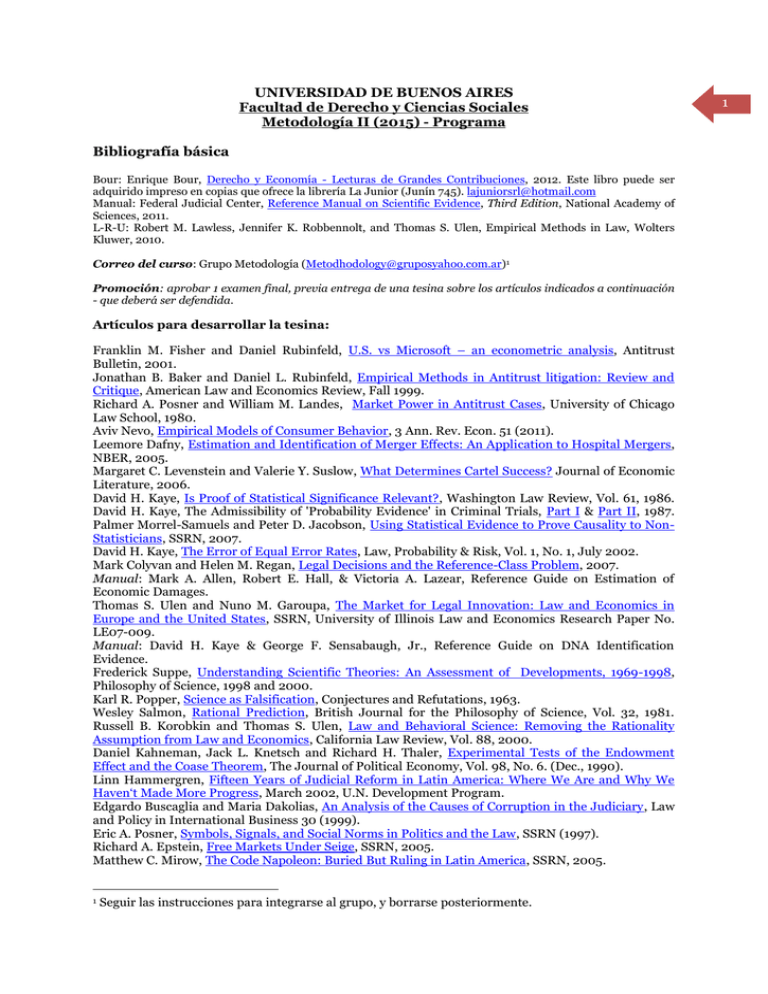
UNIVERSIDAD DE BUENOS AIRES Facultad de Derecho y Ciencias Sociales Metodología II (2015) - Programa Bibliografía básica Bour: Enrique Bour, Derecho y Economía - Lecturas de Grandes Contribuciones, 2012. Este libro puede ser adquirido impreso en copias que ofrece la librería La Junior (Junín 745). [email protected] Manual: Federal Judicial Center, Reference Manual on Scientific Evidence, Third Edition, National Academy of Sciences, 2011. L-R-U: Robert M. Lawless, Jennifer K. Robbennolt, and Thomas S. Ulen, Empirical Methods in Law, Wolters Kluwer, 2010. Correo del curso: Grupo Metodología ([email protected])1 Promoción: aprobar 1 examen final, previa entrega de una tesina sobre los artículos indicados a continuación - que deberá ser defendida. Artículos para desarrollar la tesina: Franklin M. Fisher and Daniel Rubinfeld, U.S. vs Microsoft – an econometric analysis, Antitrust Bulletin, 2001. Jonathan B. Baker and Daniel L. Rubinfeld, Empirical Methods in Antitrust litigation: Review and Critique, American Law and Economics Review, Fall 1999. Richard A. Posner and William M. Landes, Market Power in Antitrust Cases, University of Chicago Law School, 1980. Aviv Nevo, Empirical Models of Consumer Behavior, 3 Ann. Rev. Econ. 51 (2011). Leemore Dafny, Estimation and Identification of Merger Effects: An Application to Hospital Mergers, NBER, 2005. Margaret C. Levenstein and Valerie Y. Suslow, What Determines Cartel Success? Journal of Economic Literature, 2006. David H. Kaye, Is Proof of Statistical Significance Relevant?, Washington Law Review, Vol. 61, 1986. David H. Kaye, The Admissibility of 'Probability Evidence' in Criminal Trials, Part I & Part II, 1987. Palmer Morrel-Samuels and Peter D. Jacobson, Using Statistical Evidence to Prove Causality to NonStatisticians, SSRN, 2007. David H. Kaye, The Error of Equal Error Rates, Law, Probability & Risk, Vol. 1, No. 1, July 2002. Mark Colyvan and Helen M. Regan, Legal Decisions and the Reference-Class Problem, 2007. Manual: Mark A. Allen, Robert E. Hall, & Victoria A. Lazear, Reference Guide on Estimation of Economic Damages. Thomas S. Ulen and Nuno M. Garoupa, The Market for Legal Innovation: Law and Economics in Europe and the United States, SSRN, University of Illinois Law and Economics Research Paper No. LE07-009. Manual: David H. Kaye & George F. Sensabaugh, Jr., Reference Guide on DNA Identification Evidence. Frederick Suppe, Understanding Scientific Theories: An Assessment of Developments, 1969-1998, Philosophy of Science, 1998 and 2000. Karl R. Popper, Science as Falsification, Conjectures and Refutations, 1963. Wesley Salmon, Rational Prediction, British Journal for the Philosophy of Science, Vol. 32, 1981. Russell B. Korobkin and Thomas S. Ulen, Law and Behavioral Science: Removing the Rationality Assumption from Law and Economics, California Law Review, Vol. 88, 2000. Daniel Kahneman, Jack L. Knetsch and Richard H. Thaler, Experimental Tests of the Endowment Effect and the Coase Theorem, The Journal of Political Economy, Vol. 98, No. 6. (Dec., 1990). Linn Hammergren, Fifteen Years of Judicial Reform in Latin America: Where We Are and Why We Haven‘t Made More Progress, March 2002, U.N. Development Program. Edgardo Buscaglia and Maria Dakolias, An Analysis of the Causes of Corruption in the Judiciary, Law and Policy in International Business 30 (1999). Eric A. Posner, Symbols, Signals, and Social Norms in Politics and the Law, SSRN (1997). Richard A. Epstein, Free Markets Under Seige, SSRN, 2005. Matthew C. Mirow, The Code Napoleon: Buried But Ruling in Latin America, SSRN, 2005. 1 Seguir las instrucciones para integrarse al grupo, y borrarse posteriormente. 1 Juan Javier del Granado and M. C. Mirow, The Future of the Economic Analysis of Law in Latin America: A Proposal for Model Codes, Chicago-Kent Law Review, January 2008. Robert Cooter, Decentralized law for a Complex Economy: The Structural Approach to Adjudicating the New Law Merchant, 1996. Ugo Mattei, The Issue of European Civil Codification and Legal Scholarship: Biases, Strategies and Developments, 1998. Nuno M. Garoupa and Carlos Gómez Ligüerre, The Syndrome of the Efficiency of the Common Law, Boston University International Law Journal, Vol. 29, No. 2, 2011. Robert C. Ellickson, Trends in Legal Scholarship: A Statistical Study, 2000. Encyclopedia of Law and Economics, General Editors: Boudewijn Bouckaert and Gerrit De Geest, Pub. Edward Elgar and the University of Ghent, 1996-2000. I Primera Parte Estadística y Derecho 1. Métodos estadísticos y Derecho & Economía: Medición, muestreo y relaciones causales. Dócimas estadísticas. Laboratorio, investigación de campo, simulaciones y encuestas. Medidas. Fiabilidad y validez. Variables dependientes, independientes y confusivas. David Goodstein: How Science Works, a Spanish Translation, 2011. Bour, Capítulo XXII. Medición, Muestreo y Relaciones Causales. Ronald Fisher, Statistical Methods for Research Workers, Introduction, 1925. Cass R. Sunstein & William Meadow, Statistics, Not Experts (John M. Olin Program in Law and Economics Working Paper No. 109, 2000). 2. Estadística: Recopilación y Uso Apropiado de los Datos. Objetivos de la investigación científica y de un proceso legal: semejanzas y diferencias. Apreciación del Caso Daubert. Modalidades de recopilación de datos. Experimentos controlados al azar, Estudios Observacionales, Encuestas, Censos. Sesgos. Distribuciones: medidas centrales y de variabilidad. Estándares legales de prueba. Bour, Capítulo XXIII. Darrell Huff, How to lie with Statistics, 1954. Joseph L. Gastwirth, Statistical Reasoning in the Legal Setting, The American Statistician, Vol. 46, No. 1. (Feb., 1992). Jack B. Weinstein, Litigation and Statistics, Statistical Science, 1988, vol. 3 No. 3. 3. Teoría Estadística: Probabilidad, inferencia y estimación. Elementos de teoría de la probabilidad. Efectos de selección. Teorema de Bayes. Relevancia de las dócimas de significatividad estadística. P-valores. Bayesianismo vs. frecuencialismo. Correlación y regresión. Bour, Capítulo XXIII. Michael O. Finkelstein & Bruce Levin, Statistics for Lawyers, Chapter 3 – Elements of Probability, 2015. J. Lejarza e I. Lejarza, Repaso sobre probabilidades. David W. Barnes, A Common Sense Approach to Understanding Statistical Evidence, San Diego Law Review, Vol. 21, 1984. L-R-U, Cap. 1-13. 4. Práctica sobre Probabilidades. J. Lejarza e I. Lejarza, Ejercicios Teoría de la Probabilidad I. Ejercicios sobre probabilidades II. Ejercicios sobre probabilidades III. Ejercicios sobre probabilidades IV. Examen. L-R-U, Cap. 1-13. II. Segunda Parte 5. Econometría. Regresión Múltiple en Tribunales. Asociación vs causalidad. Ajuste de curvas. Forma estructural y forma reducida. Problemas de identificación. Método de mínimos cuadrados. Auto-correlación de residuos. Mínimos cuadrados generalizados. Coeficientes t-Student de los parámetros del modelo. Problemas de Especificación del modelo. Omisión de variables. Elección de la forma funcional. Interacción entre variables. Proyecciones dentro y fuera de la muestra. La Función Normal Estándar (Z), la Distribución t de Student, la distribución χ² y la Distribución F. Aplicaciones. 1) U.S. vs Microsoft. 2) Poder de Mercado y políticas anti-monopolísticas. 3) Uso de técnicas econométricas en Organización Industrial. Efectos de las fusiones. Colusión tácita y explícita. Bour, Capítulo 2 XXIV. Capítulo XXV. Capítulo XXVI. Enrique Bour, Econometría para abogados en cuestiones antitrust, 2014. Robert S. Pindyck and Daniel L. Rubinfeld, Econometric Models and Economic Forecasts, McGraw-Hill International Edition, 4th edition, 1998. III Tercera Parte 6. Ciencia, Derecho, y Futuro de Derecho y Economía. La tensión entre el derecho y la ciencia. Las teorías científicas. La innovación legal en América y en Europa. Derecho Civil y Common Law. Rol de la Codificación. La relación entre Derecho y Economía: el origen del Derecho, las normas y teoría de los juegos. Origen descentralizado del derecho. Bour, Capítulo XX. Jane Pek, Things Better Left Unwritten?: Constitutional Text And The Rule Of Law, New York, University Law Review, 83, December 2008. Richard Posner, The Decline of Law as an Autonomous Discipline: 1962-1987, 1987. Robert Cooter, Law and Unified Social Theory, 22 J.L. & Soc'y 50 (1995). 3
